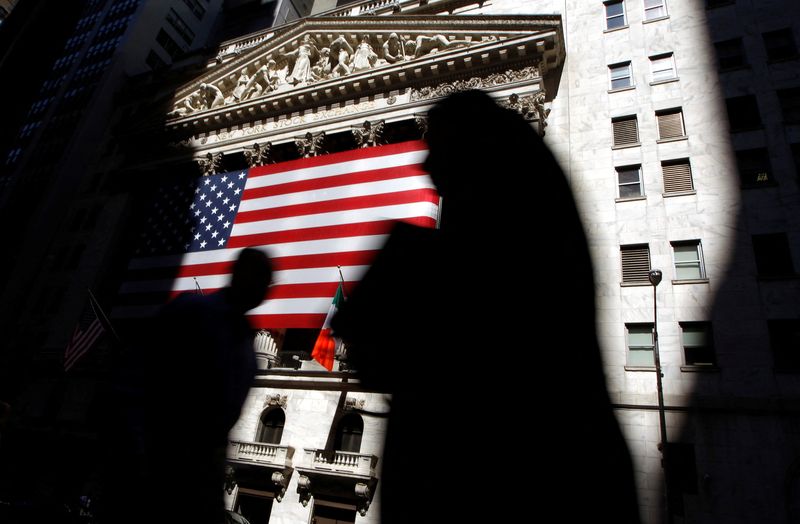Nvidia among investors in xAI’s $20bn capital raise - Bloomberg News
Investing.com -- U.S. stock futures edge higher as traders weighed comments from Federal Reserve chair Jerome Powell following the central bank's decision to resume its long-standing tightening cycle. Elsewhere, Meta Platforms delivers a second-quarter earnings beat and sounds a positive note on its massive bet on artificial intelligence, while chipmaker Intel is due to report its latest results after the bell.
1. Futures point higher after Fed decision
U.S. stock futures climbed Thursday as investors digested a widely-expected interest rate hike by the Federal Reserve that brought borrowing costs up to their highest level in more than two decades.
By 05:24 ET (09:24 GMT), the Dow futures contract added 65 points or 0.18%, S&P futures added 25 points or 0.55%, and Nasdaq 100 futures jumped by 180 points or 1.15%.
The rate-setting Federal Open Market Committee unanimously voted Wednesday to lift the benchmark federal funds rate by a quarter of a percentage point to a range of 5.25% to 5.50%, reigniting an unprecedented tightening campaign. In March 2022, the figure stood at near zero.
Commentary after the decision from Fed Chair Jerome Powell was also in the spotlight. Powell said the central bank would determine future policy on a "meeting by meeting" basis, but demurred from stating if rates will be raised again at the Fed's next gathering in September.
Adding to the overall market picture were results from social media behemoth Meta Platforms (NASDAQ:META). The Facebook owner posted double-digit revenue growth in the second quarter, while Chief Executive Mark Zuckerberg noted that the company's big bet on artificial intelligence (AI) is "paying off."
2. Powell looks to give Fed flexibility
If Jerome Powell's careful language on Wednesday is any indication, Fed policymakers seem to be keen to give themselves at least the option to explore future interest rate increases.
But, then again, Powell hinted that another hike may not be necessary.
“I would say it’s certainly possible that we will raise funds again at the September meeting if the data warranted," Powell said. “And I would also say it’s possible that we would choose to hold steady and we’re going to be making careful assessments, as I said, meeting by meeting.”
Much will likely depend on upcoming economic numbers, Powell suggested, flagging that the full impact of the Fed's aggressive monetary policy has "yet to be felt."
He added that while the tightening cycle has achieved "disinflation" without greatly damaging the labor market, there remains a chance that stronger economic activity could put new fuel into price growth. In any event, Powell said the Fed will remain "data-dependent."
3. Meta earnings beat estimates
Meta Platforms reported better-than-anticipated revenue and earnings in the second quarter as resilient customer spending and hype around AI continue to underpin the Instagram and WhatsApp owner's rebound from a dismal 2022.
Revenue expanded by 11% to $32 billion in the three months ended June 30, topping estimates of $31.12B. In particular, ad revenue, a major driver of top-line performance at Meta, rose by 12% -- faster than rival Google (NASDAQ:GOOGL). Adjusted earnings per share of $2.98 also beat expectations despite a 10% jump in costs.
Coupled with results from Google and software group Microsoft (NASDAQ:MSFT) earlier this week, Meta's returns suggest that advertisers are becoming more willing to spend on digital ads as hopes grow for a soft landing for the U.S. economy after a string of rate hikes aimed at corralling inflation.
Meanwhile, Meta boss Mark Zuckerberg said the company is starting to see the benefits from investments aimed at folding AI technology into its services. Meta is expecting to spend heavily on building out its infrastructure to support AI in the coming years to keep pace in a burgeoning arms race in Big Tech over the nascent technology.
Shares in Meta surged in premarket trading Thursday.
4. Intel on tap amid earnings parade
The frenzy around AI may remain a key topic when Intel reports its latest earnings on Thursday, with pressure rising on the U.S. chipmaking giant to change its strategy to compete with the likes of Nvidia (NASDAQ:NVDA) and Advanced Micro Devices (NASDAQ:AMD).
In May, Intel (NASDAQ:INTC) unveiled new details surrounding a chip designed specifically for AI computing, which the Santa Clara, California-based group is planning to introduce in 2025. The move comes as Intel has seen performance slump in recent quarters as a pandemic-driven bump in personal computing demand eases.
Elsewhere on Thursday, the second-quarter earnings season marches on. Payments processor Mastercard (NYSE:MA), burger chain McDonald's (NYSE:MCD), and telecommunications conglomerate Comcast (NASDAQ:CMCSA) make up some of the largest U.S. firms to report.
5. Oil prices higher on tighter supply expectations
Oil prices rose Thursday, rebounding from the previous session’s losses, as traders focused on expectations of tighter supplies from major oil producers even after the Federal Reserve resumed its rate-hiking campaign.
Saudi Arabia and Russia both recently announced plans to cut production further in August, in an attempt to boost prices by tightening global supply.
Oil prices fell on Wednesday after data showed U.S. crude inventories fell less than expected and the Fed raised borrowing costs again.
By 05:25 ET, U.S. crude futures traded 1.12% higher at $79.66 a barrel, while the Brent contract climbed 0.74% to $83.30.
